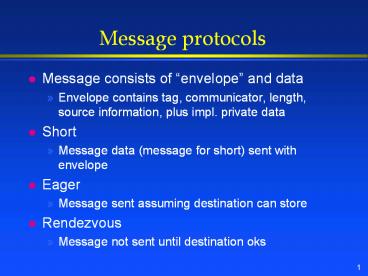Message protocols - PowerPoint PPT Presentation
Title:
Message protocols
Description:
Message not sent until destination oks. 2. Special Protocols ... May introduce additional copy (buffer to final destination) 6. How Scaleable is Eager Delivery? ... – PowerPoint PPT presentation
Number of Views:11
Avg rating:3.0/5.0
Title: Message protocols
1
Message protocols
- Message consists of envelope and data
- Envelope contains tag, communicator, length,
source information, plus impl. private data - Short
- Message data (message for short) sent with
envelope - Eager
- Message sent assuming destination can store
- Rendezvous
- Message not sent until destination oks
2
Special Protocols for DSM
- Message passing a good way to use distributed
shared memory (DSM) machines because it provides
a way to express memory locality. - Put
- Sender puts to destination memory (user or MPI
buffer). Like Eager - Get
- Receiver gets data from sender or MPI buffer.
Like Rendezvous. - Short, long, rendezvous versions of these
3
Message Protocol Details
- Eager not Rsend, rendezvous not Ssend resp., but
related - User versus system buffer space
- Packetization
- Collective operations
- Datatypes, particularly non-contiguous
- Handling of important special cases
- Constant stride
- Contiguous structures
4
Eager Protocol
Process 0
Process 1
Time
- Data delivered to process 1
- No matching receive may exist process 1 must
then buffer and copy.
5
Eager Features
- Reduces synchronization delays
- Simplifies programming (just MPI_Send)
- Requires significant buffering
- May require active involvement of CPU to drain
network at receivers end - May introduce additional copy (buffer to final
destination)
6
How Scaleable is Eager Delivery?
- Buffering must be reserved for arbitrary senders
- User-model mismatch (often expect buffering
allocated entirely to used connections). - Common approach in implementations is to provide
same buffering for all members of MPI_COMM_WORLD
this is optimizing for non-scaleable computations
7
Rendezvous Protocol
May I Send?
Data
Process 0
Process 1
Time
- Envelope delivered
- Data delivered when user-buffer available
- Only buffering of envelopes required
8
Rendezvous Features
- Robust and safe
- (except for limit on the number of envelopes)
- May remove copy (user to user direct)
- More complex programming (waits/tests)
- May introduce synchronization delays (waiting for
receiver to ok send)
9
Short Protocol
- Data is part of the envelope
- Otherwise like eager protocol
- May be performance optimization in
interconnection system for short messages,
particularly for networks that send fixed-length
packets
10
User and System Buffering
- Where is data stored (or staged) while being
sent? - Users memory
- Allocated on the fly
- Preallocated
- System memory
- May be limited
- Special memory may be faster
11
Packetization
- Some networks send data in discrete chunks called
packets
12
Non-contiguous Datatypes
- Provided to allow MPI implementations to avoid
copy
Extra copy
Network
- Not widely implemented yet
- Handling of important special cases
- Constant stride
- Contiguous structures
13
Why Bsend
- Buffer space not infinite
- Careful management of buffering required for
correctness and performance - MPI provides user control over buffering modes
- Allows implementations freedom to pick specific
protocols - Users give up some control for more convenient
general-purpose send (MPI_Send)































